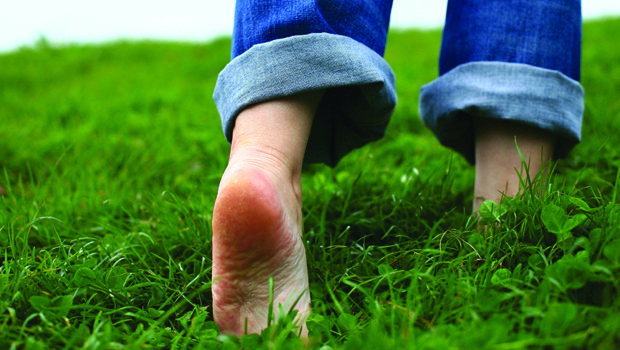Walk This Way
Step Up to Barefoot Benefits
Barefoot walking conjures images of children playing in open fields and families strolling on a beach, yet it can also embrace many other settings as part of a health and fitness routine and lifestyle of optimum wellness. As Michael Sandler and Jessica Lee attest in their new book, Barefoot Walking, “It’s not just physical; it’s soothing on an emotional and spiritual level.”
In adults, many muscles in our feet may have weakened and atrophied due to disuse from wearing shoes, which substitute the support and mobility that our bodies’ lower parts were created to provide. Years of wearing tight-fitting shoes or high heels can also hamper bone density and proper alignment of each foot’s 28 bones; produce aches and pains in knees, back and neck; and constrict circulation to legs and feet, a condition compounded by desk jobs.
Here are some tips in preparing to go shoeless:
Work out feet. Prevention.com advises working to individually wiggle each toe; touch and rub each in its entirety; and flex and move both feet in as many different ways as possible. This will help them better absorb and distribute weight. Then, suggest Sandler and Lee, try “grabbing” exercises for toes, picking up round objects ranging in size from golf balls to baseballs. Also practice arch lifts, calf raises and ankle rolls.
Check it out. Walk around a room and note if the weight upon landing moves from the heel to the big toe right away; if so, try shifting bodyweight while walking so that the pressure proceeds from the heel to the little toe and then across to the big toe. This maximizes functioning of the entire foot and keeps the arch from collapsing inward. This subtle change helps support knees, the pelvic floor and even abdominal muscles.
Fields, dirt trails and beaches are ideal sites to start walking barefoot. Repeated skin-to-ground contact also coincides with grounding, or earthing, a therapy that connects a being with Earth’s electrical field. The concept is that this allows negatively charged free electrons to enter and eliminate free radicals, the positively charged particles that may cause diseases and inflammation. When we’re in shoes, “We’re separated [from the Earth] by an inch of rubber, which is a fantastic resistor to electricity,” the co-authors point out.
Because barefoot walking stimulates foot nerve endings, it’s also a form of self-reflexology, helping to lower blood pressure and anxiety while bolstering the immune system.
For all these reasons, enthusiasts conjecture that it’s wise to follow in the natural footsteps of healers past and present that have chosen to walk this way.
The human foot is a masterpiece of engineering and a work of art.
~ Leonardo da Vinci
Sandler provides special tips on getting started for some specific groups:
Children: “They haven’t had their feet weakened by wearing shoes for many years, so let them develop their own style.”
Pregnant women: Start with a tiger walk technique (land with the heel barely off the ground, focusing on grabbing traction with the toes) for as much stability and fullest contact with the ground as possible.
Seniors: Use a walk and roll technique (lift the forefoot up before gently landing heel first) to keep weight directly beneath the body’s center of gravity. “Some seniors are fearful of going barefoot; concerned their feet are soft and sensitive. But they find that it actually helps them regain balance, coordination and body-brain connections.”
A key to expanding onto terrains like gravel and pavement while avoiding injury is to build up stronger plantar skin on the bottom of the feet, because it is “600 percent stronger than skin elsewhere and can grow even thicker, up to half an inch, but only if you use it,” according to Sandler and Lee. “Going about barefoot stimulates additional skin growth (layering) and pushes the moisture out of the skin (strengthening), which together, thicken the soles of your feet.”
Other basic tips to avoid injury include: go slow, build foot strength, focus on form, learn to rest, inspect feet daily for potential nicks or scratches and see a physician if in doubt about anything.
“Once you’re aware of your surroundings and have toughened up your feet, you’ll avoid most sharp objects and be relatively shielded from the rest,” advise Sandler and Lee, who see the activity as a big step toward greater overall health awareness. “You’ll learn more about your body… what’s right and what’s not, what’s working and what can be improved.”
























